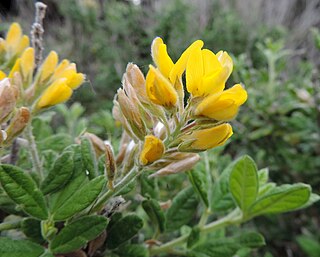
Julbernardia is a genus of plants in the family Fabaceae. There are eight species found in tropical Africa. They are medium-sized trees.
Lecointea is a genus of flowering plants in the family Fabaceae. It contains the following species:
Tessmannia is a genus of flowering plants in the family Fabaceae.
Pierreodendron is a genus of plants in the family Simaroubaceae.
Grazielodendron riodocensis is a species of flowering plant in the legume family, Fabaceae. It belongs to the subfamily Faboideae, and was recently assigned to the informal monophyletic Pterocarpus clade within the Dalbergieae. It is the only member of the genus Grazielodendron. It is only found in Brazil.
Steyermarkochloa is a genus of plants in the grass family. The only known species is Steyermarkochloa angustifolia(Spreng.) Judz., which is native to Colombia (Guainía), Venezuela (Amazonas), and Brazil (Amazonas).

Tinnea is a genus of plants in the family Lamiaceae first described in 1867. It is native to sub-Saharan Africa. It was named in honour of the explorer Alexandrine Petronella Francisca Tinné.
- Tinnea aethiopicaKotschy ex Hook.f. - widespread from Mali to Somalia south to Mozambique; naturalized in Trinidad & Tobago
- Tinnea antiscorbuticaWelw. - Zaïre, Zambia, Angola
- Tinnea apiculataRobyns & Lebrun - eastern Africa from Rwanda to Mozambique
- Tinnea barbataVollesen - Swaziland, northern South Africa
- Tinnea barteriGürke - western Africa
- Tinnea benguellensisGürke - Angola
- Tinnea coeruleaGürke - Zaïre, Zambia, Angola
- Tinnea eriocalyxWelw. - Zaïre, Angola, Botswana, Namibia
- Tinnea galpiniiBriq. - Mozambique, Swaziland, South Africa
- Tinnea gossweileriRobyns & Lebrun - Angola
- Tinnea gracilisGürke - Tanzania to Zambia
- Tinnea mirabilis(Bullock) Vollesen - Tanzania
- Tinnea physalisE.A.Bruce - Tanzania
- Tinnea platyphyllaBriq. - Zaïre
- Tinnea rhodesianaS.Moore - South Africa, Namibia, Zimbabwe, Zambia, Angola, Mozambique
- Tinnea somalensisGürke ex Chiov. - Ethiopia
- Tinnea vesiculosaGürke - Tanzania, Malawi
- Tinnea vestitaBaker - Zimbabwe, Zambia, Angola, Botswana
- Tinnea zambesiacaBaker - Zimbabwe, Zambia, Malawi, Mozambique
Mortoniella is a monotypic genus of flowering plants in the family Apocynaceae, first described as a genus in 1939. It contains only one known species, Mortoniella pittieri, native to Central America.

Rivasgodaya is a monotypic genus of flowering plants belonging to the legume family, Fabaceae. It just contains one species, Rivasgodaya nervosa.
Robbrechtia is a genus of flowering plants belonging to the family Rubiaceae.
Roigella is a monotypic genus of flowering plants belonging to the family Rubiaceae. It only contains one known species, Roigella correifolia(Griseb.) Borhidi & M.Fernández
Gereaua is a monotypic genus of flowering plants belonging to the family Sapindaceae. It only contains one species, Gereaua perrieri(Capuron) Buerki & Callm.
Ianhedgea is a monotypic genus of flowering plants belonging to the family Brassicaceae. It only contains one species, Ianhedgea minutiflora(Hook.f. & Thomson) Al-Shehbaz & O'Kane
Lackeya is a monotypic genus of flowering plants belonging to the family Fabaceae. It only contains one known species, 'Lackeya multiflora'(Torr. & A.Gray) Fortunato, L.P.Queiroz & G.P.Lewis It has the common name of Boykin's Clusterpea.
Nichallea is a monotypic genus of flowering plants belonging to the family Rubiaceae. It only contains one species, Nichallea soyauxii(Hiern) Bridson
Saintpauliopsis is a monotypic genus of flowering plants belonging to the family Acanthaceae. It only contains one known species, Saintpauliopsis lebruniiStaner
Normandiodendron is a monotypic genus of flowering plants belonging to the family Fabaceae. It only contains one known species, Normandiodendron bequaertii(De Wild.) J.Léonard
Letestuella is a monotypic genus of flowering plants belonging to the family Podostemaceae. The only species is Letestuella tisserantiiG.Taylor
Ochoterenaea is a monotypic genus of flowering plants belonging to the family Anacardiaceae. The only species is Ochoterenaea colombiana.
Poggea is a genus of flowering plants belonging to the family Achariaceae.


